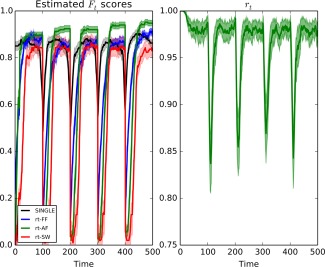Figure 3.

Left: Mean F scores for the offline SINGLE algorithm and the real‐time algorithms using either a sliding window (rt‐SW), a fixed forgetting factor (rt‐FF), or adaptive forgetting respectively (rt‐AF). Here, the underlying network structure was simulated using scale‐free random networks according to the preferential attachment model of Barabási and Albert [1999]. A change occurred every 100 time points. We note that all three algorithms experience a drop in performance in the vicinity of these change‐points, however in the case of the real‐time algorithms the drop is asymmetric. Moreover, we further note that when adaptive forgetting is used the real‐time algorithm is able to outperform its offline counterpart in sections where the data remains piece‐wise stationary for long periods of time.
Right: mean values for the estimated adaptive forgetting factor, , over time. We note there is a sudden drop directly after changes occurs allowing the algorithm to adequately discard irrelevant information. [Color figure can be viewed at http://wileyonlinelibrary.com.]
